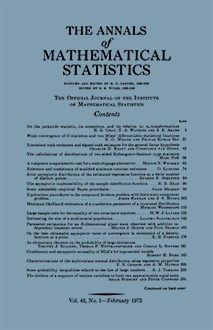Abstract
Let $\{x_1, x_2,\cdots\}$ be a sequence of i.i.d.r.v. with mean zero, variance one, and (1) $\mathbf{P}(|x_k| \geqq \lambda) \leqq C \exp(-\alpha\lambda^\varepsilon)$ for positive $\alpha, \varepsilon$. Let $f(t, x)$ (with its first partial derivatives) be of slow growth in $x$, let $F_n(x)$ be the distribution function of $(1/n) \sum^n_1 f(k/n, s_k/n^{\frac{1}{2}})$ where $s_k = x_1 + x_2 + \cdots + x_k$, and let $F(x)$ be the distribution function of $\int^1_0 f(t, w(t)) dt$ where $\{w(t)\}$ is Brownian motion. Then $\sup_x |F_n(x) - F(x)| = O((\log n)^\beta/n^{\frac{1}{2}})$ provided $F(x)$ has a bounded derivative. The proof uses the Skorokhod representation; also, a theorem is proven which would indicate that the Skorokhod representation cannot be used in general to obtain a rate of convergence better than $O(1/n^{\frac{1}{4}})$. A corresponding result is obtained if (1) is replaced by the existence of a finite $p$th moment, $p \geqq 4$.
Citation
Stanley Sawyer. "Rates of Convergence for Some Functionals in Probability." Ann. Math. Statist. 43 (1) 273 - 284, February, 1972. https://doi.org/10.1214/aoms/1177692720
Information





